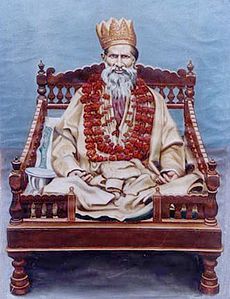Shiv Dayal Singh
This article includes a list of general references, but it lacks sufficient corresponding inline citations. (November 2018) |
Shiv Dayal Singh | |
|---|---|
Rai Saligram ,Grib Dass | |
| Profession | Founder and first spiritual leader of Radha Soami sect |
Shiv Dayal Singh (25 August 1818 – 15 June 1878), known by the honorific "Param Purush Puran Dhani Huzur Soami Ji Maharaj" by his disciples and devotees, was an Indian spiritual guru and founder of Radha Soami, a 19th-century spiritual sect.[1]
Early life
The parents of Shiv Dayal Singh were residents of Punjab, but moved to
Adulthood
After Shiv Dayal Singh completed his education, he became a Persian language translator to a government officer.[5] He left the job and became a teacher of Persian language. Once his brother gained an employment at Indian post office, he left his Persian language job, and joined his father's moneylending business. He spent increasing amount of his time, to religious pursuits. He began giving spiritual discourses based on the scriptures of Sikhism and writings of Tulsi Sahib of Hathras.[5]
Practice
After the death of Sant Tulsi Saheb in 1843, Shiv Dayal Singh practised Surat Shabd Yoga for 17 years in almost total seclusion in a room within a room.[7] He started holding Satsang (spiritual discourse) publicly on Vasant Panchami (a spring festival) in 1861, and continued for 17 years.[8] Thus Basant Panchami is a very special day for the followers of the Radhasoami Faith.[9]
Teachings
Shiv Dayal Singh originally referred to the Supreme Being with the names "Sat Nām" (True Name) and "Anāmi" (Nameless). The term Rādhāsoāmi was used after



His bani (poetical compositions) and sayings from satsang were published in two books after he died. Both are called Sar Bachan or Sar Vachan (meaning 'conclusive utterances') :[15][16][17]
- Sar Vachan Vartik (Sar Bachan in prose)
- Sar Vachan Chhand Band (Sar Bachan in verse)
Sar Vachan Vartik is in two parts: part one being an introduction written by Salig Ram and part two compiled of notes taken from the discourses of Shiv Dayal Singh, which he delivered in satsang up to 1878. They cover important teachings of the faith. His poems in Sar Vachan Chhand Band are replete with emotional appeal - a blending of popular poetic expressions from different languages of north India such as, Khari-Boli,
Soami Bagh and Dayal Bagh
The locality called "Soami Bagh" ("Soami Ji's Garden"), the former home of Shiv Dayal Singh and the present location of his tomb-shrine, is currently owned by the Radha Soami Satsang Agra branch, and controlled by the twin organisations known as the Radhasoami Satsang Central Administrative Council and the Radhasoami Trust (called "the Council and the Trust" for short). Its across-the-street neighbour "Dayalbagh" ("Garden of the Merciful") is owned and controlled by the organisation Radha Soami Satsang Dayalbagh. Dayal Bagh and its founder-guru Anand Swarup, Kt. were broadcast to the Western public by Paul Brunton in his famed A Search in Secret India. Sir Anand Swarup received a knighthood for the massive social construction work performed at Dayal Bagh. The two organisations, Council/Trust and Dayalbagh, are both existent and functioning. The major dispute between the two groups is due to two divergent views: The members of Council/Trust claim that Council/Trust is the "parent stock" of Radhasoami faith.
The members of Dayalbagh Sabha want access to the tomb-shrine of Shiv Dayal Singh. The tomb-shrine (called ‘Samadh’), was built over 100 years by efforts of the Council/Trust. Soami Bagh Council/Trust allows all satsangis and tourists to visit Samadh, but does not allow religious processions in the Holy Samadh from anyone outside the Council/Trust. In this light, Dayalbagh Sabha organised "SPIRICON 2010", a conference of various organisations who revere Shiv Dayal Singh (boycotted by Council/Trust), to promote mutual respect and to petition access to the tomb-shrine of Shiv Dayal Singh.[citation needed]
See also
References
- ISBN 0-691-01092-7.
- ISBN 0-691-01092-7.
- ^ Jivan Charitar Hazur Maharaj by Ajodhyā Parshād, p. 36.
- ^ Jivan Charitar Soāmiji Mahārāj by Partap Singh Seth, p. 6.
- ^ ISBN 0-691-01092-7.
- ^ Singh Seth, Lala Pratap. Biography Of Soamiji Maharaj: Sant Radhasoami Sahib, Seth Shiv Dayal Singh. Radhasoami. p. 23. Retrieved 8 May 2022.
- ^ Sār bachan : an abstract of the teachings of Swamiji Maharaj, the founder of the Radha Swami system of philosophy and spiritual science, the yoga of the sound current. Dera Baba Jaimal Singh, Beas : Radha Soami Satsang Beas. 1978. p. 2. Retrieved 8 May 2022.
- ^ Prui, Lekh Raj (1972). Radha Swami teachings : as given in Swami ji's book 'Sar bachan' poetry. Beas, India : Radha Soami Satsang. p. 7. Retrieved 8 May 2022.
- ^ Lavania, Deepak (21 January 2018). "Basant day: Festivity grips Dayalbagh: 20,000 to attend Basant Day celebrations". The Times of India. Retrieved 8 May 2022.
- ^ Sār Vachan Chhand Band. p. 4.
- ^ The Radhasoami Tradition by David C. Lane. Garland Publishing, Inc., New York, 1992. Archived 17 May 2011 at the Wayback Machine
- ^ Sār Bachan Nasar Yāni Vārtik.
- ^ Maheshwari, B. D. (29 August 1994). Biography Of Radhaji Maharaj. Retrieved 8 May 2022.
- ^ Singh, Shiv Dayal. Sar Bachan. Retrieved 8 May 2022.
- ^ Radhasoamisatsang.org: Books by Swami ji Maharaj
- ^ Radhaswamidinod.org: Books by Swami ji Maharaj Archived 8 October 2008 at the Wayback Machine
- ECKANKAR, 1977, page 149. ("Sardar" Seva Singh was the Radha Soami Satsang Beastranslator of the Sar Bachan into English.)
External links
- http://www.radhasoamisatsang.org
- https://web.archive.org/web/20080410220324/http://www.radhaswamidinod.org/faith.htm
- http://www.aors-dbbs.org/index.html
- http://www.sikh-heritage.co.uk/movements/radhasoamis/The%20radhasoamis.htm
- http://malankazlev.com/kheper/topics/chakras/chakras-SantMat.htm
- https://web.archive.org/web/20080509170243/http://www.seekersway.org/seekers_guide/radhasoami_1_g.html
- http://www.radhasoami-faith.info/Books_Frame.shtml
- Radha Soami Satsang Beas
- Science of the Soul
- Sant Mat - Surat Shabd Yoga: Contemporary Guru Lines & Branches
- http://radhasoamidayal.net/GuruIntro.html
- http://eacharya.inflibnet.ac.in/data-server/eacharya-documents/548158e2e41301125fd790cf_INFIEP_72/110/ET/72-110-ET-V1-S1[permanent dead link]
